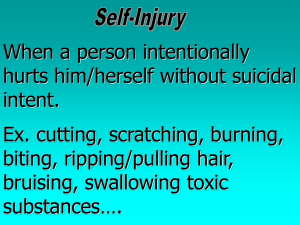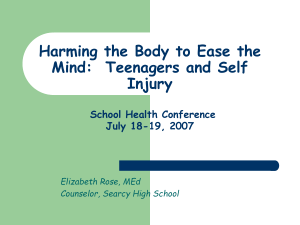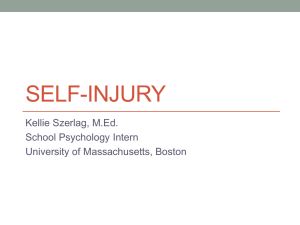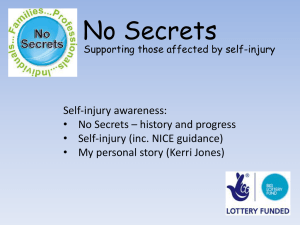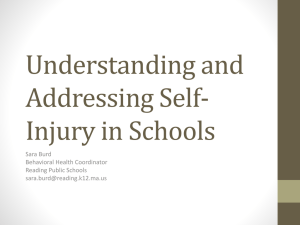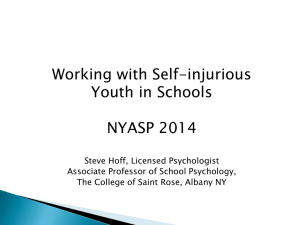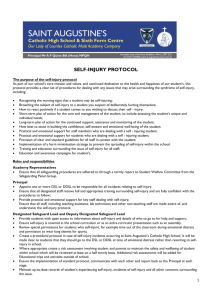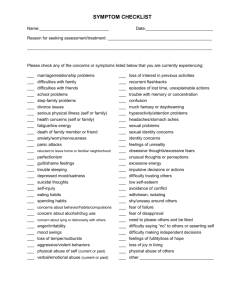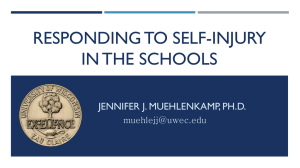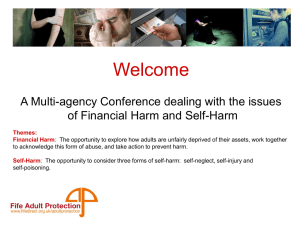See My Pain 2013 - Developmental Resources, Inc.
advertisement
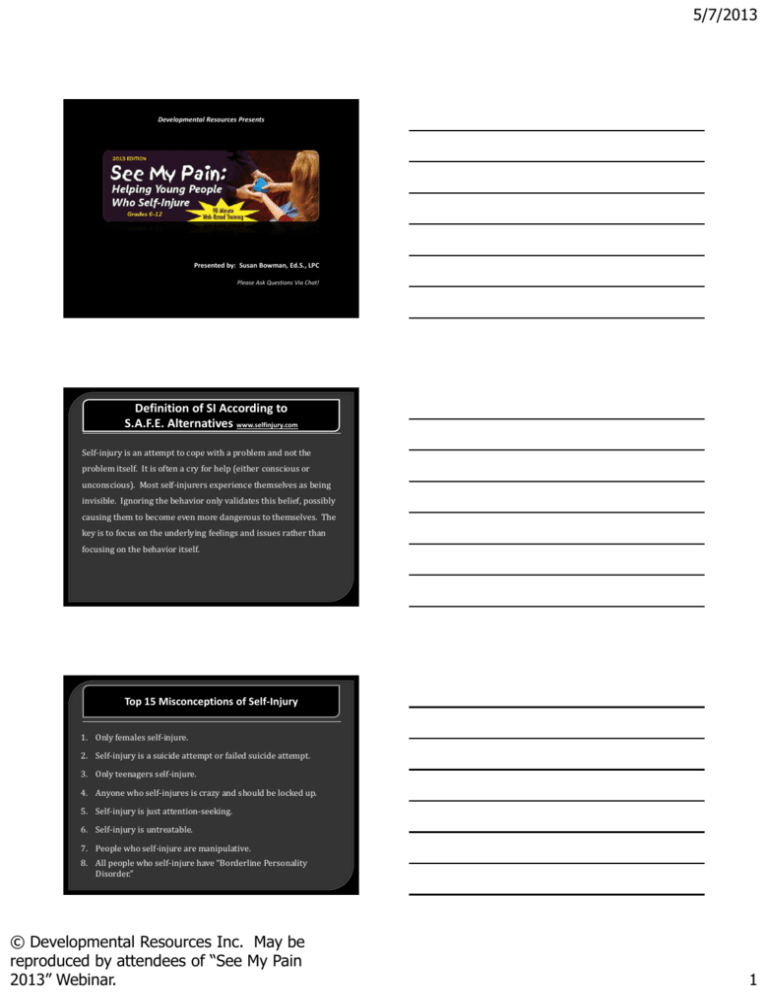
5/7/2013 Developmental Resources Presents Presented by: Susan Bowman, Ed.S., LPC Please Ask Questions Via Chat! Definition of SI According to S.A.F.E. Alternatives www.selfinjury.com Self-injury is an attempt to cope with a problem and not the problem itself. It is often a cry for help (either conscious or unconscious). Most self-injurers experience themselves as being invisible. Ignoring the behavior only validates this belief, possibly causing them to become even more dangerous to themselves. The key is to focus on the underlying feelings and issues rather than focusing on the behavior itself. Top 15 Misconceptions of Self-Injury 1. Only females self-injure. 2. Self-injury is a suicide attempt or failed suicide attempt. 3. Only teenagers self-injure. 4. Anyone who self-injures is crazy and should be locked up. 5. Self-injury is just attention-seeking. 6. Self-injury is untreatable. 7. People who self-injure are manipulative. 8. All people who self-injure have “Borderline Personality Disorder.” © Developmental Resources Inc. May be reproduced by attendees of “See My Pain 2013” Webinar. 1 5/7/2013 Top 15 Misconceptions of Self-Injury 9. People who self-injure only cut themselves. 10. Anyone who self-injures is part of the “Gothic” or “Emo” subgroup. 11. People who self-injure enjoy the pain or they can’t feel it. 12. There’s nothing I can do to help. 13. All people who self-injure have been abused. 14. Someone who self-injures can stop if they really want to. 15. Someone who self-injures is a danger to others. Coping Checklist Healthy Unhealthy • Write my feelings out • Eat too much • Do something nice for another person • Blame someone else • Talk to someone • Play a musical instrument • Use humor • Do something active like ride my bike, run, etc. • Sleep too much • Use alcohol or other drug • Smoke • Refuse to talk about it • Think of hurting myself • Fight with others • Play with my dog/cat • Draw, paint • Use the Internet to chat with others • Use internet to hurt others or myself "I hurt myself for different reasons, depending on my state of mind. I do it sometimes as a way to get relief from the pain I am feeling inside. Other times I do because at the time I feel I deserve to be punished, or I am angry at myself, but really I think someone else. Other times I do it to "shout out" to the world that I need help and here is the proof. I am a incest survivor, so I think that it's some of the pain that I have had to live with trying to escape my body.” (Dianne, Age 30, Canada) © Developmental Resources Inc. May be reproduced by attendees of “See My Pain 2013” Webinar. 2 5/7/2013 Statistics National Center for Injury Prevention and Control • 3 million Americans engage in some form of self-injury. • An estimated 3 million Americans purposely cut or burn themselves. • 90% of people who self-injure begin cutting as teenagers. • The average person who self-injures starts at age 14 and continues with increasing severity into her late 20's. Statistics National Center for Injury Prevention and Control • More than half of people who self-injure are victims of sexual abuse, and most report emotionally abusive or neglected childhoods. • Self-injury is prevalent in ALL races and economic backgrounds. • In a recent Canadian population based survey of youth ages 14 to 20, three quarters of those who had ever self-harmed were females and most began in mid adolescence. Why Do I Self-Injure? "I cut myself because I feel so much pain inside that I need a way to release it all. So by cutting myself, it acts as an outlet for that l pain, I guess, somehow. It feels like it's all running out of me when I see myself bleeding. I know that probably sounds gross to most people who don't do this. Yes, I am in group therapy for people who self-injure". (Chrissy, Age 17, USA) © Developmental Resources Inc. May be reproduced by attendees of “See My Pain 2013” Webinar. 3 5/7/2013 Why Do Young People Engage in Self-Inflicted Violence? • Relief from feelings • Method of coping • Stopping, inducing or preventing dissociation • Physically expressing pain • Communication • Self-nurturing • Self-punishment • Reenacting previous abuse • Establishing control Types of Self-Injury 1. Major Self-Mutilation: Includes such things as castration, amputation of limbs, enucleation of eyes. Fairly rare and usually associated with psychotic states. 2. Stereotypic Self-Injury: Comprises the sort of rhythmic headbanging, etc. seen in autistic, mentally retarded and psychotic people. 3. Superficial or Moderate: Most Common form of selfmutilation. Includes cutting, burning, scratching, skin-picking, hair-pulling, bone-breaking, hitting, deliberate overuse injuries, interference with wound healing, and virtually any other method of inflicting damage on oneself. Most popular act is cutting. Sites include wrists, upper arms and inner thighs. Bullying & Self-Harm • According to a new study, children who are bullied are three times more likely than others to self-harm by the time they are 12 years old. • A team of researchers from the United States and the United Kingdom said its findings could help identify those at greatest risk for this type of behavior. • Although the study cannot tell us the exact nature of the relationship between bullying and self-harm, it does highlight the importance of giving victims of bullying care and support to cope with the possible emotional and psychological effects. © Developmental Resources Inc. May be reproduced by attendees of “See My Pain 2013” Webinar. 4 5/7/2013 Princess Diana The disorder made its first major public appearance when Princess Diana confessed that the strain of her marriage had caused her to throw herself down the staircase and cut herself with razors, pen knives and lemon slicers. Internet/Blog Sites "I knew I was always the ugly one. Don't say that's a lie because you don't know what some kids have said and done. It hurts to think about how mean some people could be. Even when I started to look a little better, they still couldn't see.” “The only reason I even bother to tell my sad sob story is that someday the public might know what a teenage girl goes Kristina, 15 years old through.” Researchers studied the top 100 videos of such acts on YouTube and found they had received more than 2 million page views. © Developmental Resources Inc. May be reproduced by attendees of “See My Pain 2013” Webinar. 5 5/7/2013 Suggestions for Professional Counselors • Create an environment that provides empathy, caring, unconditional acceptance, trust and rapport. (MacAniff & Kiselica, 2001; Conterio & Lader, 2002) • Build on the child/adolescent’s personal strengths and instill hope. (Selekman, 2002). • Do’s & Don’ts Do... • Show the child/adolescent unconditional acceptance. • Encourage a commitment to try positive alternative behaviors for coping. • Invite open communication no matter what the behavior. • Communicate that it is okay to talk about self-injury. Don’t... • Be afraid to ask the question, “Do you self-injure?” • Make eliminating the behavior the primary goal. • Tell the child/adolescent to stop the self-injury behavior. • Use contracting as a reward or punishment system. • Make him/her feel ashamed or guilty about his/her behavior. © Developmental Resources Inc. May be reproduced by attendees of “See My Pain 2013” Webinar. 6 5/7/2013 Goals for Treatment • Assess danger to self. • Assess for referral for inpatient/outpatient treatment. • Provide safe environment. • Explore and develop safe alternatives. • Teach new coping skills. • Improve self-image. • Use cognitive restructuring/reframing. • Improve interpersonal relating. • Improve self-esteem. Comfort Kit • Small journal & pen • Glitter wand • Hand lotion • Drawing pad & markers • Names of people who you can call • Biofeedback card • Sand timer • An object representing a personal strength • A soft stone Reflective Journaling • Can elicit self-understanding • Provides a non-threatening way to get out feelings • Looks at past events and allows expressions of anger • Recalls pleasant memories that convey hope • Helps release stress and redirects harmful thoughts • Keeps them from harming © Developmental Resources Inc. May be reproduced by attendees of “See My Pain 2013” Webinar. 7 5/7/2013 The knife at my wrist, the pill on my tongue, The blood at my hands, the tears in my eyes, What does not kill me makes me stronger. It’s that which leads me to this. It makes me feel clean, washing away all the impurities that were induced into my body by others when I was a child. Something has been released - any emotion I’m feeling leaves my body with blood. When I saw the blood I felt nothing, just numbness. It shows me I’m alive and it shows me the emotional pain I feel is real. Art Therapy It is based on the belief that the creative process involved in artistic self-expression helps people to resolve conflicts and problems, develop interpersonal skills, manage behavior, reduce stress, increase self-esteem and self-awareness, and achieve insight. American Art Therapy Association © Developmental Resources Inc. May be reproduced by attendees of “See My Pain 2013” Webinar. 8 5/7/2013 Sand Tray Why Use Sand Tray Therapy? Sand Tray translates personal experience into a concrete, threedimensional form. As a picture can say more than a thousand words, a figure or scene can express feelings, emotions and conflicts that previously had no verbal language. Hence, the sand-worlds that are created offer a rich and highly personalized vocabulary for pre-verbal or non-verbal experience. Without having to depend on words, clients can increase their capacity for expression through the tray. Selfawareness and communication are enhanced by this process. Sandplay Therapists of America Relaxation/Guided Imagery • A way to work on unresolved issues • Helps control breathing during stressful times • An acceptable way to reach an altered state of consciousness • A way to rehearse skills, visualize the future • Can control emotional pain • Healthier way to deal with stress and emotional pain © Developmental Resources Inc. May be reproduced by attendees of “See My Pain 2013” Webinar. 9 5/7/2013 Peer Helping Resources for training peer listeners: Elementary Level: Children Helping Children & Becoming a Friendly Helper by Myrick & Bowman Middle/High School: Caring & Sharing by Myrick & Erney Training Peer Helpers by Barbara Varenhorst Success Stories & Testimonies Autobiographies & Inspiring Memoirs • Dave Pelzer (suffered years of abuse by his mother) • Oprah Winfrey (was molested as a child) • Fiona Apple (raped at 12, became anorexic) • Johnny Depp (low self-esteem, drugs, dropped out of school) • Memoir Star by Karres & Bowman http://self-injury.net/doyousi/famous/ www.bipolarworld.net/Self-Injury Developmental Resources Presents Presented by: Susan Bowman, Ed.S., LPC Please Ask Questions Via Chat! © Developmental Resources Inc. May be reproduced by attendees of “See My Pain 2013” Webinar. 10 5/7/2013 Available from YouthLight www.youthlight.com 2013 CONFERENCES www.dev-resources.com © Developmental Resources Inc. May be reproduced by attendees of “See My Pain 2013” Webinar. 11 Presented by Susan Bowman, Ed.S., LPC Coping Checklist Place a check next to the approaches that best fits your style of coping with personal problems. Healthy Write my feelings out Do something nice for another person Talk to someone Play a musical instrument Use humor Do something active like ride my bike, run, etc. Play with my dog/cat Draw, paint Unhealthy Eat too much Blame someone else Sleep too much Use alcohol or other drug Smoke Think of hurting myself Refuse to talk about it Fight with others Discussion Questions: How many did you mark under “Healthy” compared to “Unhealthy?” What are the long-term effects of each one you checked? What are other ways you can cope with problems? List these below: 2 STATISTICS • 3 million Americans engage in some form of self-injury • An estimated 3 million Americans purposely cut or burn themselves • 90% of people who self-injure begin cutting as teenagers • The average person who self-injures starts at age 14 and continues with increasing severity into her late 20's. • More than half of people who self-injure are victims of sexual abuse, and most report emotionally abusive or neglected childhoods • Self-injury is prevalent in ALL races and economic backgrounds • In a recent Canadian population based survey of youth ages 14 to 20, three quarters of those who had ever self-harmed were females and most began in mid adolescence. • 83.2% reported at least one episode of self-injury. • Almost 40 % of those who had ever self-harmed, did so repeatedly (i.e., more than three times). (Interdisciplinary National Self-Injury In Youth Network Canada) • Over two thirds of youth who self-harmed believed that they got the idea themselves, while much fewer indicated that the idea came from friends, family or the media (Nixon, Cloutier, & Jansson, 2008). According to the National Center for Injury Prevention and Control more than 250,000 people each year are treated in US emergency departments for nonfatal self-inflicted injuries. Most past research indicates that women are more likely to self-harm than men but in 2006, a Cornell University study proved this ratio is quickly closing. The study did show though, that women are twice as likely to scratch, pinch and cut themselves as men, who are more apt to punch things to injure their hands. (http://www.theravive.com/services/cutting.htm) 3 Why Do Young People Engage in Self-Inflicted Violence? • Relief from feelings • Method of coping • Stopping, inducing or preventing dissociation • Physically expressing pain • Communication • Self-nurturing • Self-punishment • Reenacting previous abuse • Establishing control 4 The Internet and Self-Injury: What Psychotherapists Should Know Article by, Janis L. Whitlock, Wendy Lader, and Karen Conterio The growing presence of self-injury on the web parallels the proliferation of self-injury awareness of in American society. Two decades ago, self-injury was largely unknown to the public and generally carried out in privacy. Researchers speculate that its spread into popular culture gathered momentum in the 1990’s when more than 14 pop icons revealed self-injurious habits in various media outlets. The same period saw a significant increase in the number of movies, music, and news articles with self-injury scenes or themes. Today, a myriad of television shows, such as DeGrassi, Interventions, Grey’s Anatomy, and Seventh Heaven, portray the physical and emotional details of self-injury in ways that may highlight it as an available emotional outlet for individuals predisposed to the behavior (Whitlock & Knox, in press). Indeed, virtual socializing venues such as “myspace.com” have overtaken malls as the primary socializing venue for teens. Instant messaging (IM) has flourished as a means of exchange with 75% of online teens (65%) of all teens saying that they use IM to keep in touch with a broad network of friends and family (Lenhart, Madden, & Hitlin, 2005). With Internet use increasing at a rapid rate, chances are good that when self-injurious clients enter psychotherapy they will have already used on-line resources to find information about self-injury, particularly if they are an adolescent or young adult. In a study of self-injury message boards, informal support and discussion of proximal life events that trigger self-injury were the most common types of exchange followed by casual and sometimes personal information related to the addictive qualities of their practice, their fears relating to disclosure, experiences with psychotherapy, how they self-injure, and other related health concerns (Whitlock, et al., 2006). In most Internet modalities, users are entirely free to observe and post whatever they choose. In web-based blog communities, such as myspace.com, xanga.com, and Facebook, anyone can sign up for an account and post content. However, they may not be allowed to post indiscriminately on the sites of other subscribers since posting privileges on each individual blog are dictated by the account holder. YouTube uses a similar format with video creators able to control what is and is not posted on their site. Message boards utilize a slightly different format and often vary considerably by degree of moderation. Moreover, individuals immersed in self-injury communities may experience what we think of as “narrative reinforcement” – the sharing of similar life stories and interpretations which can normalize and subconsciously justify the use of self-injury. While it is possible that narrative reinforcement may eventually lead people to recognize the damage suffered by themselves and others by self-injurious behavior, it may also keep them from identifying and attending to its underlying causes. Despite the fact that psychotherapy, in the popular mind, equates healing with the cathartic verbal release of pain, research has shown that dwelling on painful feelings without exploring and challenging irrational thoughts may actually do more harm than good (e.g., Pomerantz, 2006). Moreover, sites which feature video footage or photos, such as YouTube, often include images of severe injury and graphic poetry and artwork – much of which is likely to be highly suggestive or triggering to self-injurious participants. And, while many people who self-injure express a strong desire to find lasting interpersonal relationships, they often need help working through a number of impediments to same, including a history of trauma and past disappointments. Such opportunities are not easily encountered on the web. This entire article can be viewed on the following website: www.focusas.com/Selfinjury.html Janis Whitlock Family Life Development Center Cornell University, Ithaca, NY 14853 Videos on Self-Injury: http://vimeo.com/20938569 http://www.childline.org.uk/Videos/Pages/WillsStoryRaisingawarenessofselfharm.aspx Types of Self-Injury 5 Major Self-Mutilation • Includes such things as castration, amputation of limbs, enucleation of eyes. • It is fairly rare and usually associated with psychotic states. Stereotypic Self-Injury • Comprises the sort of rhythmic head-banging, etc, seen in autistic, • Mentally retarded and psychotic people. Superficial or Moderate • Most common form of self-mutilation. • Includes cutting, burning, scratching, skin-picking, hair-pulling, bone-breaking, hitting, deliberate overuse injuries, interference with wound healing, and virtually any other method of inflicting damage on oneself. • Most popular act is cutting; sites include wrists, upper arms, and inner thighs. Famous Self-Injurers Princess Diana "You have so much pain inside yourself that you try and hurt yourself on the outside because you want help." "Diana: Her True Story," a biography written on the princess said that Diana had thrown herself into a glass cabinet at Kensington palace at various times, slashed her wrists with a razor, and cut herself with the serrated edge of a lemon slicer. Once, during a heated argument with Prince Charles, she picked up a penknife and cut her chest and thighs. Her husband still scorned her, and thought she was faking her problems, that it was melodramatic attention seeking. During a fight on an airplane, Diana locked herself in the bathroom, cut her arms, and smeared the blood over the cabin walls and seats. Another time she threw herself down the stairs. Angelina Jolie "I was..trying to feel something....I was looking at different things..thinking romantically about...about blood. I really hurt myself," and also said, "I was just....a kid. I was like 13, And, I was saying that it is not something that is cool. It’s not cool. And I understand that it is a cry for help..." Marilyn Manson In a 1998 Rolling Stone interview he answered some questions regarding his self-injury, both onstage and offstage. About self-injury he said, "I think that's all a form of wanting to let go, of wanting to get out," and, "It's not something easily described or understood." About the differences between his onstage self-injury and offstage self-injury he said, "I think onstage it was more me trying to show people my pain, and offstage it was just feeling it, period." 6 Trigger Log Directions: Place a Check Mark or Plus (+) Sign on every day that you DO NOT self-injure. Place a Question Mark (?) on the day(s) that you DO self-injure. Week Mon Tues Wed Thurs Fri Sat Sun Then ask yourself these questions: 1. If you did NOT self-injure…why not. What was going on that day, what did you do? Who did you have contact with that day? What worked for you on the day you did not self-injure. 2. If you did self-injure…What triggered the self-injury on this day? Was it internal thoughts or external factors or both? 3. Next try and identify a pattern. Do you mainly self-injure on a weekday? Weekend? Is there a specific time of day? Can you identify what happens at these specific times? 7 Describing Feelings and Triggers 1. What was happening just before self-mutilation behavior? 2. What was the link to body sensations? 3. How does the self-abusive behavior occur? Checklist for the Cycle of My Emotions Focusing on how you were feeling before you hurt yourself, write a B next to each of the emotions that you felt before you hurt yourself. Then, write a D beside any emotion you experienced during hurting yourself. Finally, write an A next to each emotion you felt after you hurt yourself. _____ Anger _____Wholeness _____ Euphoria _____ Frustration _____ Happiness _____ Elation _____ Hopelessness _____ Disconnection _____Pride _____ Sadness _____ Depression _____ Relief _____ Isolation _____ Hostility _____ Numbness _____ Alienation _____ Tension _____ Loneliness _____ Shame _____ Fear _____ Emptiness _____ Anxiety _____ Guilt _____ Other (Adapted from Alderman, 1997) 8 Goals for Treatment 1. Assess danger to self 2. Assess for referral for inpatient/outpatient treatment 3. Assess for co-morbidity 4. Provide safe environment 5. Explore and develop safe alternatives 6. Improved coping 7. Improved body image 8. Cognitive restructuring/reframing 9. Improved interpersonal relating 10. Improved self-esteem 11. Family Intervention 9 Suggestions for Professional Counselors • Create an environment that provides empathy, caring, unconditional acceptance, trust and rapport (MacAniff & Kiselica, 2001; Conterio & Lader, 2002) • Build on the child/adolescent’s personal strengths and instill hope (Selekman, 2002). The primary need for these clients is to be heard, understood, validated, and taught healthier ways of coping with their emotions. Once a positive, trusting relationship is established, a multifaceted approach can be incorporated into the treatment plan including learning how to replace selfdestructive behaviors with effective self-management skills (MacAniff & Kiselica, 2001). DO • • • • • • • • • • • • Show the child/adolescent unconditional acceptance. Accept him/her as a person regardless of the behavior. Make understanding the underlying causes for the behavior a goal. Encourage a commitment to try positive alternative behaviors for coping. Suggest a list of coping techniques to be used rather than self-injury. Understand that this list is flexible and can always change. Encourage open communication no matter what the behavior. Acknowledge his/her efforts to cope with very difficult emotions. Show that you care about the injuries. Communicate that it is okay to talk about self-injury. Help him/her discover their identity. Remember that you are not responsible for the child/adolescent’s behavior. DON’T • • • • • • • • • Be afraid to ask the question, “Do you self-injure?” Make eliminating the behavior the primary goal. Tell the child/adolescent to stop the self-injury behavior. Use contracting as a reward or punishment system. Make a safety contract. This may create a need to please you and further the feelings of inadequacy for the child/adolescent. Make him/her feel ashamed or guilty about his/her behavior. Feel responsible for the child/adolescent decision to self-injure. Be the only source of support for the child/adolescent. Leave the family out of the healing process. Copied with permission from Bowman and Randall. (2004). See My Pain! Creative Strategies and Activities for Helping Young People Who Self-Injure. Chapin: SC. Youthlight, Inc. 10 Peer-Based Programs We all know that tweens and teens would rather talk about personal issues to another peer than to an adult. By training students to be Peer Listeners in the school, students have someone to talk to about personal problems including any thoughts of self-harm. It is recommended that those selected to be Peer Listeners are from all social and ethnic backgrounds and are a good representation of the culture of that school. With this taken into consideration the next step is to interview potential students to be sure they would be a good fit. Training needs to be based on the Peer Helping Model and be led by a school counselor or someone who has experience in Peer Helper training. The national association has information on training. (http://www.peerprogramprofessionals.org) It was established in 1984 and its mission is to help adults establish, train, supervise, maintain and evaluate peer programs using the NAPPP Standards and Ethics as a guiding principle. Resources for training peer listeners: • Elementary Level: Children Helping Children & Becoming a Friendly Helper by Myrick & Bowman • Middle/High School: Caring & Sharing by Myrick & Erney • Training Peer Helpers by Barbara Varenhorst Some peer led programs: • Mean Girls Aren’t Cool (http://www.meangirlsnotcool.com/) • Mean Stinks (www.facebook.com/secretmeanstinks) • The Bullycide Project http://thebullycideproject.com/) • Safe Schools Ambassadors (http://www.safeschoolambassadors.org/aboutssa_video.php) • K.A.R.M.A. (Kids Against Ridicule Meanness and Aggression) (http://www.thekarma.org/) • SHINE, Students Helping Instill New Esteem (http://www.loveourchildrenusa.org/loc_youth_ambassadors.php) • PACER Teens Against Bullying (http://www.pacerteensagainstbullying.org/#/home) • A WORLD OF DIFFERENCE® Institute Peer Leadership Program (http://www.partnersagainsthate.org) 11 Copied with permission from Bowman and Randall. (2004). See My Pain! Creative Strategies and Activities for Helping Young People Who Self-Injure. Chapin: SC. Youthlight, Inc. 12 Journaling Can elicit self-understanding Provides a non-threatening way to get feelings out Looks at past events and allows expressions of anger Recalls pleasant memories that convey hope Helps release stress and redirects harmful thoughts Keeps them from harming Write a summary for each: A favorite memory: A time you felt very proud: A time you expressed yourself without self-injuring: Copied with permission from Bowman and Randall. (2004). See My Pain! Creative Strategies and Activities for Helping Young People Who Self-Injure. Chapin: SC. Youthlight, Inc. 13 Art Therapy Art Therapy It is based on the belief that the creative process involved in artistic self-expression helps people to resolve conflicts and problems, develop interpersonal skills, manage behavior, reduce stress, increase self-esteem and self-awareness, and achieve insight. (American Art Therapy Association) Recommended Book: Self-Mutilation and Art Therapy: Violent Creation by Diana Milia 14 Sandtray Translates personal experience into a concrete, threedimensional form. As a picture can say more than a thousand words, a figure or scene can express feelings, emotions and conflicts that previously had no verbal language. Hence, the sand-worlds that are created offer a rich and highly personalized vocabulary for pre-verbal or non-verbal experience. Without having to depend on words, clients can increase their capacity for expression through the tray. Self-awareness and communication are enhanced by this process. Sandplay Therapists of America 15 Relaxation/Guided Imagery • A way to work on unresolved issues • Helps control breathing during stressful times • An acceptable way to reach an altered state of consciousness • A way to rehearse skills, visualize the future • Can control emotional pain • Healthier way to deal with stress and emotional pain 16 References & Resources Safe Alternatives, http://www.selfinjury.com Alderman, T. (2000). The Scarred Soul: Understanding & Ending Self-Inflicted Violence. YouthLight, Inc. Bowman, S., and Randall, K. (2004). See My Pain! Creative Strategies for Helping Young People Who Self-Injure. YouthLight, Inc. Cloud, H., Townsend, J. (1999). Boundaries: When to Say Yes, When to Say No to Take Control of Your Life. Conners, R. (2000). Self-Injury: Psychotherapy With People Who Engage in SelfInflicted Violence. Bookmart press. Conterio, K. and Lader, W. (1998). Bodily Harm: The Breakthrough Healing Program for Self-Injurers. Hyperion. Covey, S. Simon, and Schuster, (1998). The 7 Habits of Highly Effective Teens. Free Press Holmes, A. (2000). Cutting the Pain Away: Understanding Self-Mutilation. Chelsea House publishers. Levenkron, S. (1998). Cutting: Understanding & Overcoming Self-Mutilation. YouthLight, Inc. Ng, G. (1998). Everything You Need to Know About Self-Mutilation: A Helping Book for Teens Who Hurt Themselves. Rosen Publishing Group Phillips, B. (1995). Controlling Your Emotions Before They Control You. Harvest House Publishers. Selekman, M. (2002). Solution-Oriented Brief Family Therapy With Self-Harming Adolescents. W.W. Norton and Company. Strong, M. (1998). A Bright Red Scream: Self-Mutilation and the Language of Pain. The Penguin Group. 1-888-HOPE-307 (National number for teen support) doorofhope4teens@aol.com 17
